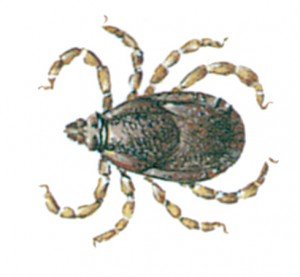
(Latin: Rhipicephalus sanguineus)
This tick originates from Africa but is now widely distributed throughout the tropical and subtropical areas of the world. In Europe it is common in the Mediterranean countries.
It occurs mainly on dogs and rarely on man. Like the previous species it has to have three separate blood meals before it becomes sexually mature, and under favourable conditions development from egg to adult takes about 65 days at a temperature of 25-30° C.
In temperate areas the dog tick is completely dependent upon warm buildings during the cold part of the year. As it originally evolved in very dry climates, it is able, unlike the castor bean tick, to live and breed in centrally heated houses with a dry climate.
Fully fed female dog ticks are scarcely one centimetre long when they leave the host, and this most often happens in the dog’s bed. Even in this condition they are surprisingly mobile and while searching for a suitable site for egg-laying they have a tendency to wander upwards.
The 2,000-4,000 red-brown eggs are attached in large or small clumps in a sheltered position, as for example small cavities in panelling, along piping or behind cupboards and pictures.
To control these ticks it is essential to treat both the dog and the surrounding areas at the same time.




